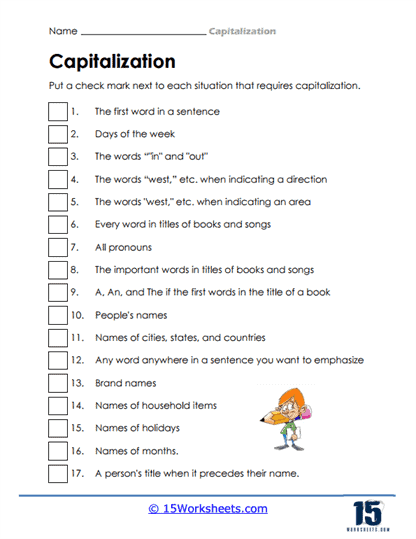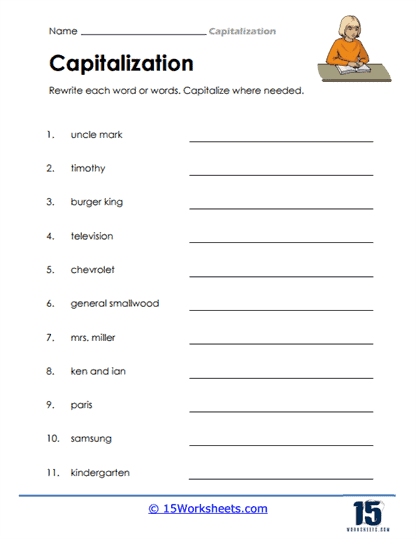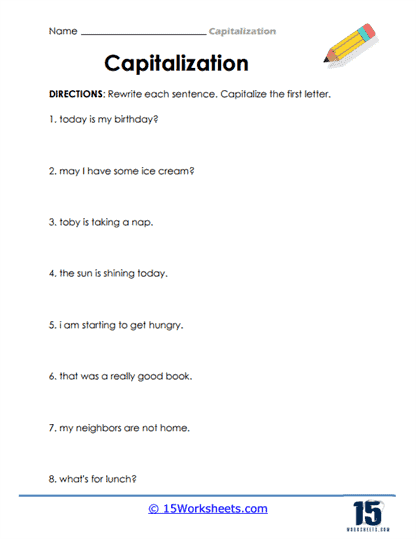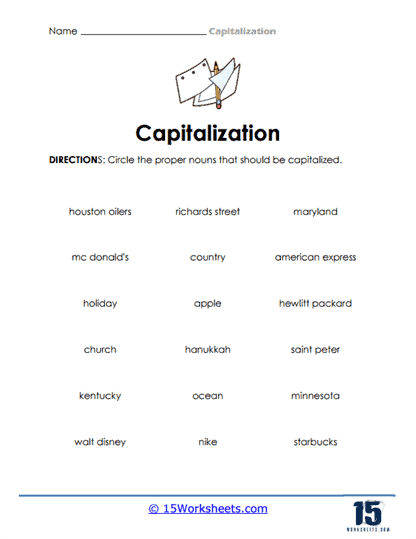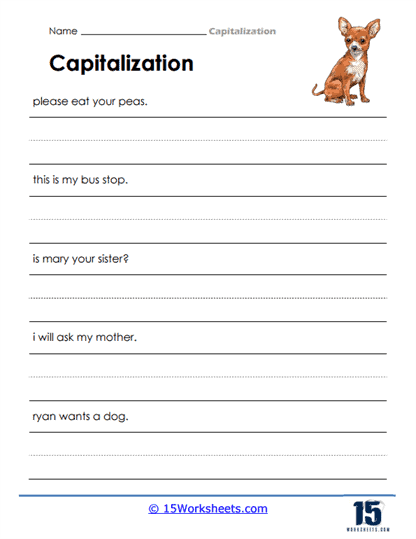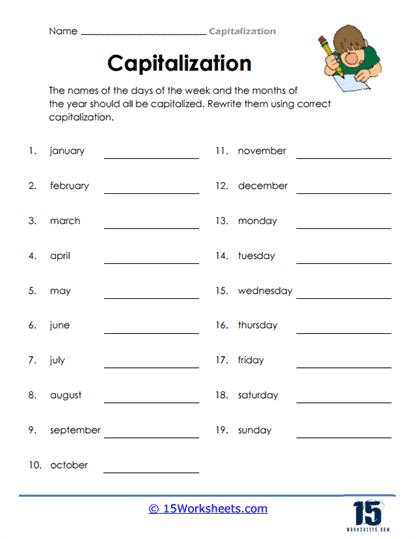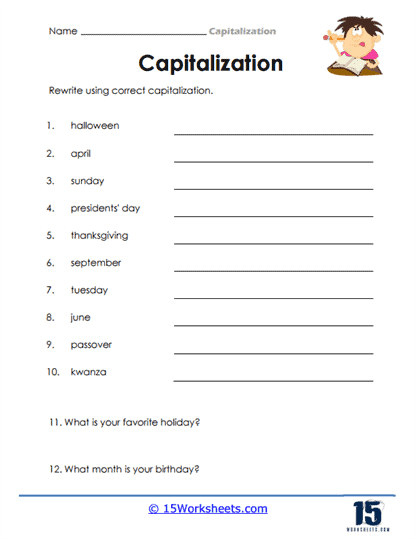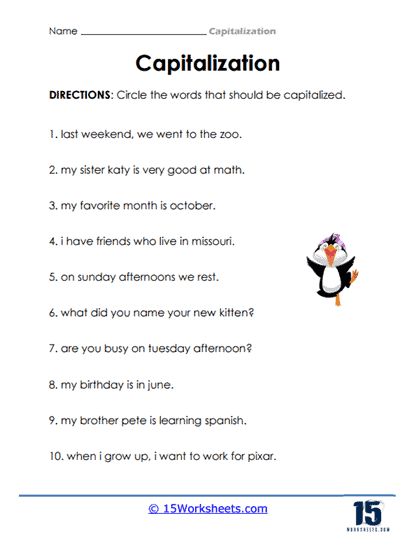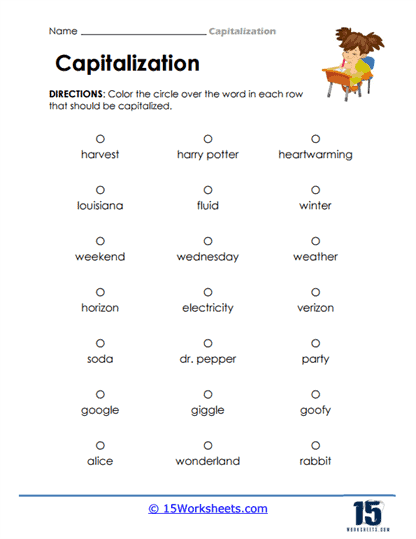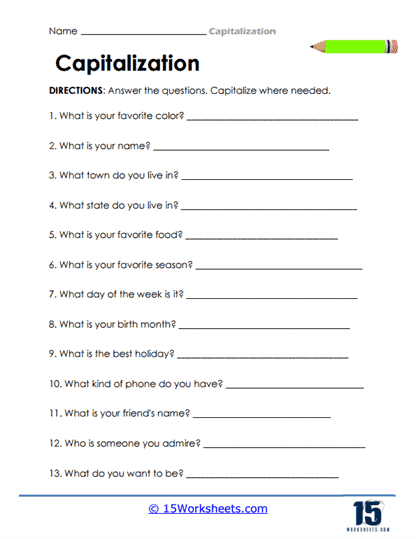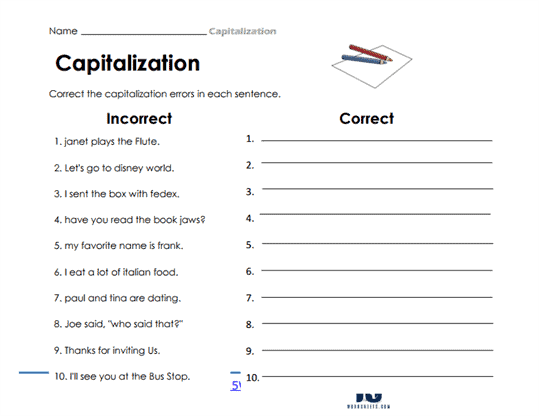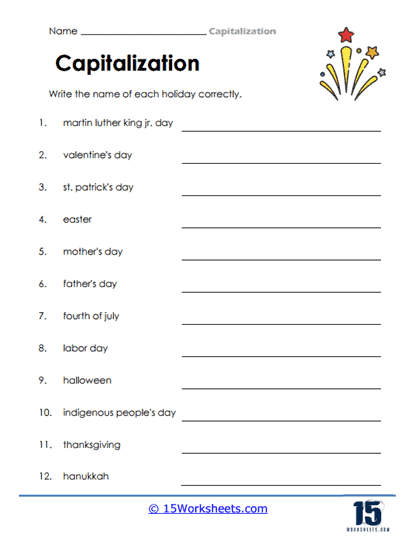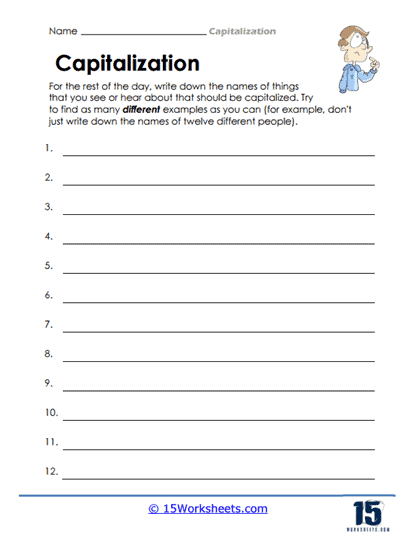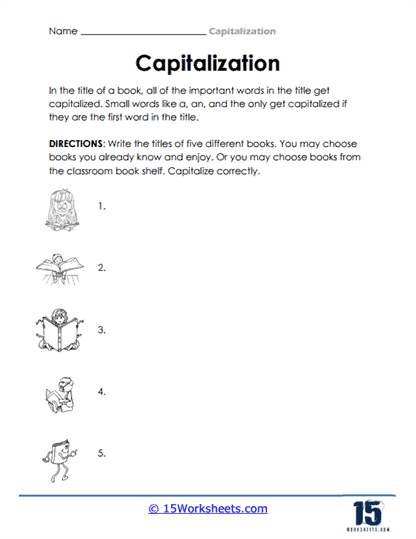Capitalization Worksheets
All About These 15 Worksheets
These worksheets will help you practice and improve your skills in using capital letters correctly. These worksheets provide exercises and activities that focus specifically on when and how to use capital letters in writing.
We have several different types of worksheets and tasks associated with them including:
Rules of Capitalization – These worksheets will teach you the important rules of when to use capital letters. You will learn that the first letter of a sentence should always be capitalized. You will also learn that proper nouns, which are the names of specific people, places, or things, are always capitalized. For example, names of cities, countries, people, and brands are proper nouns.
Titles – Worksheets may include exercises on capitalizing titles of books, movies, songs, and other works. You will learn that important words in titles, such as nouns, pronouns, verbs, adjectives, and adverbs, should be capitalized. Smaller words, like articles (a, an, the), conjunctions (and, but, or), and prepositions (in, on, at), are typically not capitalized unless they are the first or last word of the title.
Proper Adjectives – Proper adjectives, which are adjectives formed from proper nouns, are capitalized. For example, “American” in “American flag” or “French” in “French cuisine” would be capitalized.
Names and Pronouns – Worksheets may include exercises that focus on capitalizing names of people, places, and things. You will learn that when you refer to yourself using the pronoun “I,” it should always be capitalized.
Sentence Corrections – Some worksheets may provide sentences with capitalization errors, and your task will be to identify and correct those errors. This activity will help you practice recognizing when capital letters are missing or incorrectly used in a sentence.
The purpose of these worksheets is to help you understand and apply the rules of capitalization consistently in your writing. By practicing with these worksheets, you will become more confident in using capital letters correctly, which will make your writing more accurate and clear.
What Are the Rules of Capitalization?
Here are the key rules of capitalization in detail, including when to use capital letters in various contexts.
1) 1st Letter of a Sentence – Every sentence should begin with a capital letter. This helps to identify the start of a new idea or thought.
Example – “The sun is shining brightly today.”
2) Proper Nouns – Proper nouns are the names of specific people, places, organizations, and things. They should always be capitalized.
Examples:
“Sarah went to New York City for her vacation.”
“I love reading books by J.K. Rowling.”
3) Personal Pronoun “I” – The pronoun “I” should always be capitalized, regardless of its position in a sentence.
Example – “I am going to the park with my friends.”
4) Titles – In general, the important words in titles of books, movies, songs, poems, and other works are capitalized. Articles (a, an, the), conjunctions (and, but, or), and prepositions (in, on, at) are usually not capitalized unless they are the first or last word of the title.
Example – “Harry Potter and the Philosopher’s Stone”
5) Days, Months, and Holidays – Days of the week, months of the year, and holidays are capitalized.
Examples:
“My birthday is on Tuesday.”
“We celebrate Christmas in December.”
6) Names of Specific Places – Names of cities, countries, continents, mountains, rivers, and oceans are capitalized.
Examples:
“Paris is the capital of France.”
“The Nile River is the longest river in Africa.”
7) Names of Languages and Nationalities – Names of languages and nationalities are capitalized.
Examples:
“She speaks Spanish fluently.”
“My friend is of Italian descent.”
8) Proper Adjectives – Proper adjectives are adjectives formed from proper nouns. They should be capitalized.
Examples:
“We had a delicious Italian pizza for dinner.”
“The Statue of Liberty is an iconic American symbol.”
9) First Word in a Direct Quotation – When quoting someone directly, the first word of the quotation is capitalized.
Example – My friend said, “I love playing soccer.”
10) Capitalize Significant Historical Events and Documents – Names of important historical events, such as World War II or the Renaissance, and names of significant documents, such as the Declaration of Independence, are capitalized.
11) Specific Terms and Titles – Specific terms and titles referring to particular people or roles are capitalized.
Examples:
“President Lincoln gave an inspiring speech.”
“I want to become a doctor when I grow up.”
12) Brand Names and Trademarks – Names of specific brands, trademarks, and company names are capitalized.
Examples:
“I bought a new iPhone.”
“Nike is a popular sportswear brand.”
13) First Letter of Each Word in a Proper Noun – If a proper noun consists of multiple words, such as the name of a book or a movie, capitalize the first letter of each word.
Example – “The Lord of the Rings”
14) Abbreviations and Acronyms – Capitalize each letter in abbreviations and acronyms.
Examples:
“NASA (National Aeronautics and Space Administration)”
“DVD (Digital Versatile Disc)”
15) The First Word After a Colon in a Salutation or Greeting – In formal writing, the first word after a colon in a salutation or greeting is capitalized.
Example – “Dear Sir:”
It’s important to note that these rules of capitalization may have exceptions in certain cases, such as specific style guides or formatting requirements for different types of writing. However, following these general rules will help you use capital letters correctly in most situations.

